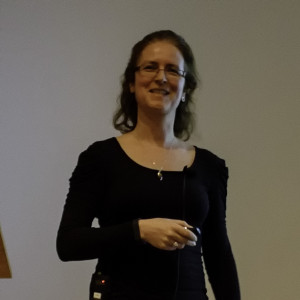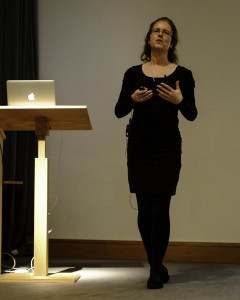April 14, 2014
The Current Solar Cycle – Why is it Misbehaving?
Professor Louise Harra
Report by: Mike Meynell
Professor Louise Harra is professor of solar physics at UCL Mullard Space Science Laboratory and came to the Flamsteed to talk about the current solar cycle and why it might (or might not!) be unusual in comparison to previous solar cycles.
Louise started with an explanation of solar cycles. Solar cycles have been known about and observed for nearly two hundred years, with reconstructions of the solar cycle (based on sunspot observations) dating back to the early seventeenth century. It is a reasonably regular cycle with an average duration of around 11 years (22 years if you include the magnetic cycle).
There are three main processes that need to be understood in relation to the solar cycle. Firstly, the Sun is a magnetic star. These magnetic fields structure the outer layers of the Sun, as well as the corona and solar wind. Secondly, the Sun consists of plasma, so convection processes take place causing a constant churning of material. Finally, the Sun has differential rotation, with the region around the equator rotating much faster than the poles, which twists the Sun’s magnetic field and causes an increasingly complex magnetic structure as the solar cycle progresses.
The solar minimum prior to the current solar cycle lasted longer than many people predicted. During this extended solar minimum, the solar wind was weaker. The current cycle has been weaker than previous cycles, and we are currently coming out of a second peak in solar activity within this cycle. This peak, however, has been significantly lower than peaks in previous cycles, with sunspot numbers far lower than witnessed in the last cycle.
In addition, the magnetic polarity of the Sun reverses as part of the 11-year solar cycle. During this cycle, the North Pole has flipped in polarity, but the South Pole hasn’t. The South Pole is still changing, but it hasn’t quite flipped in polarity yet.
Sunspots can be the location of huge explosions, known as solar flares. As the Sun is full of magnetic field, which is being moved about by convection and differential rotation, it is inevitable that magnetic fields will reconnect, causing these solar flares and, potentially, coronal mass ejections. Solar flares are like tens of millions of hydrogen bombs going off in a matter of minutes. They are 10,000 times hotter than a volcanic eruption, with the atmosphere moving at enormous speeds, many hundreds of kilometres per second, 60-times faster than a hurricane! There flares can occur at any point in the solar cycle, though they are more common at times of solar maximum.
In coronal mass ejections, a mass in excess of Mount Everest is ejected from the Sun. A coronal mass ejection hitting Earth can have huge consequences, particularly given our modern day reliance on technology. The first solar flare that was witnessed in 1859, by Richard Carrington at the Kew Observatory, caused widespread disruption to telegraph networks. The consequences of a similar event in modern times are likely to be much more severe, so prediction of these events is a huge area of research.
There are some other bizarre consequences of high solar activity. During geomagnetic storms, it is unsafe for racing pigeons to fly! Also, an analysis of whales between 1712 and 2003 has shown that more whales are stranded when solar activity is high.
The impact of solar activity on Earth’s climate is also an important, and controversial, area of current research. The extended solar minimum during the late seventeenth century, known as the “Maunder Minimum”, seems to correspond to a time of decreased temperatures… a “little ice age”. During this time, winter fairs on a frozen Thames were a common occurrence. At periods of low solar activity, the Earth experiences a drop-off in solar energetic particles and an increase in galactic cosmic rays. The impact on climate is still not understood, but it seems clear that there is a connection.
So, are we experiencing an unusual solar cycle? Looking at the record over the last 400 years, the current cycle does not appear very unusual. There have been several periods of low solar activity in the past. However, in the modern era, the cycle is unusual, but only because we have seen comparatively high levels of activity over the course of the last century. What we don’t know is whether the low activity in this cycle is a prelude to another extended solar minimum.
The next mission that Louise is working on is the ESA Solar Orbiter mission. This is due to be launched in 2017 and is designed to give detailed measurements of the heliosphere and the solar wind, from an eccentric orbit that takes it inside the orbit of Mercury. Hopefully, this mission will give us a better understanding of the Sun and, by monitoring the build up of magnetic activity in the atmosphere, potentially allow predictions of flares and eruptions.
Our sincere thanks to Louise for a fascinating talk. We wish her all the very best in her future research.
Pictures from the Evening (by Mike Meynell):
Posted under: Flamsteed, Flamsteed Lecture, Meeting Report






You must be logged in to post a comment.